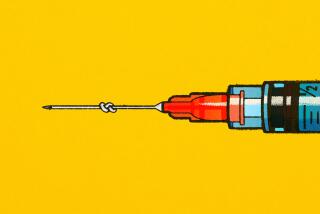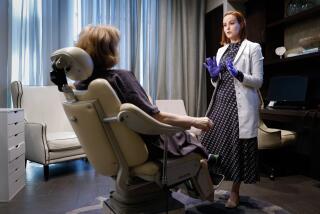Botox Maker’s Latest Wrinkle: Bid for Breast Implant Firm
- Share via
Botox maker Allergan Inc. has made a $3.2-billion offer to buy a Santa Barbara breast implant company, illustrating how cosmetic medicine is evolving from a niche business to a lucrative part of the pharmaceutical mainstream.
If successful, the bid would position Irvine-based Allergan to prosper in a business that is booming not only in Southern California, but across the globe. In the United States, an aging baby boomer population is helping to drive the trend.
“Allergan’s strategy here is: ‘If you’re thinking about cosmetic surgery and image, then it’s all about Allergan,’ ” said Ken Trbovich, an analyst with RBC Capital Markets in Denver. “They want to be a one-stop shop.”
Allergan, a specialty pharmaceutical company that sells eye, skin and other treatments, has seen profit soar with Botox, an anti-wrinkle injection used to treat lines around the eyes. The company made its play for silicone-gel breast implant maker Inamed Corp. late Monday, topping a $2.6-billion bid by Medicis Pharmaceutical Corp. in Scottsdale, Ariz.
Americans spent $12.5 billion on cosmetic procedures in 2004, up more than 37% from $9.1 billion the year before, according to data from the American Society for Aesthetic Plastic Surgery.
Nonsurgical cosmetic enhancements, such as Botox treatments, grew to 9.1 million procedures, an increase of 51% from the year before, the trade group said.
“These things are far more acceptable and becoming more broadly used by Middle America -- some people are going into debt to do these things,” Trbovich said.
Inamed and Allergan are a compelling combination because the deal would “marry Botox cosmetics with complementary medical aesthetic products” made by Inamed, such as anti-wrinkle injections to the cheeks and breast implants, said Douglas Ingram, general counsel of Allergan.
Ingram said Allergan hoped the deal would close by January.
Shares of Allergan, a $13-billion company that earned $150 million on sales of $606 million in the quarter ended Sept. 30, dropped $2.60 to $96.25.
Inamed, worth $2.7 billion based on Monday’s closing price, earned $14.9 million on sales of $105.2 million in the same quarter. Its shares jumped more than 9% to $81.28, while Medicis dropped 10% to $26.70.
In September, Inamed suddenly became a more attractive acquisition target when the Food and Drug Administration gave the firm an “approvable letter,” a conditional OK to resume sales of silicone breast implants, which were once threatened by health worries and litigation.
Inamed still must comply with undisclosed conditions before it gets final government approval to sell the implants for cosmetic surgery, ending a 13-year ban.
Analysts have predicted annual sales increases of more than $30 million with the OK. One other firm, Mentor Corp., also in Santa Barbara, has received the same approval.
Inamed executives did not return calls Tuesday. The company was formed in 1974 to make medical devices for plastic and reconstructive surgery and eventually expanded into breast implants and collagen products. With manufacturing facilities in Fremont, Calif., Ireland and Costa Rica, it has more than 500 employees.
Analysts predicted there wouldn’t be much of a takeover battle for Inamed, which received the Medicis bid nine months ago. Since then, Medicis shares have fallen as its financial results disappointed Wall Street.
Allergan made a cash-and-stock offer for Inamed valued at $84 per Inamed share -- more than 15% higher than the Medicis bid.
Inamed shareholders, such as Stamford, Conn.-based SAC Capital Advisors, have publicly criticized the Medicis bid as too low.
With Inamed, Allergan and Mentor based in California, as are many laser medical device firms, analysts said, it makes sense that the Golden State would become a center for companies that make a living on refining images.
“If you look at this industry, where’s all the excitement, where’s all the innovation? It’s on the West Coast,” said Thomas Gunderson, an analyst at investment firm Piper Jaffray who follows the industry.
Gunderson said the cosmetic medicine industry had become more attractive to Wall Street for several reasons. For one, because most cosmetic procedures are not covered by insurance, most patients pay in cash or with a credit card.
Another reason: aging baby boomers.
“We weren’t sure what they would do,” Gunderson said. But in recent years it’s become clear “that they wanted to go to the grave looking good.”
More to Read
Inside the business of entertainment
The Wide Shot brings you news, analysis and insights on everything from streaming wars to production — and what it all means for the future.
You may occasionally receive promotional content from the Los Angeles Times.










